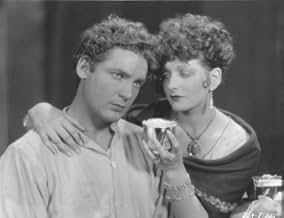Natalie Kingston(1905-1991)
- Actress
She traced her lineage back to the first Spanish governor of
California. Her great-grandfather on her mother's side was
Hungarian-born Agoston Haraszthy, dubbed the father of Californian
viticulture. Leggy, olive-complexioned Natalia Ringstrom grew up and
was educated in the San Francisco Bay area. Little is known of her
early years, except that she was trained in traditional Spanish dance
(including La Jota, the folk dance of Aragon), and, while still in her
early teens, travelled the short distance to San Francisco to perform
in cabaret. She was spotted there as a blossoming talent by the
renowned ballroom dancers Fanchon and Marco, eventually joining their
revue on tour. Next stop: Broadway. Now billed as Natalie Kingston, she
was featured as one of the chorines of the 1920 "Brevities" at the
Winter Garden Theatre. There was to be no career on the stage, however,
since Natalie returned to California, soon to becoming a
Mack Sennett Bathing Beauty.
Natalie joined Sennett's Keystone 'Fun Factory' sometime in 1923. Over the next three years, the soulful-eyed brunette worked her way steadily up the cast list, from ornamental bit parts and walk-ons to fifth billing(Romeo and Juliet (1924)); fourth (Wall Street Blues (1924)); third (Galloping Bungalows (1924)); to finally co-starring with comic greats Harry Langdon, Billy Bevan and Ben Turpin in a series of classic two-reel farces, including Remember When? (1925) and His First Flame (1927) (as a gold digger). When Natalie eventually left Sennett for Paramount, she had every intention of finding 'serious' dramatic work. Instead, the studio continued to use her as a bankable comedy asset in three back-to-back six-reel features: Wet Paint (1926), Miss Brewster's Millions (1926) and The Cat's Pajamas (1926), all palpable box-office hits. In between flappers and 'nice girls', Natalie also had a turn as a vamp in Eddie Cantor's Kid Boots (1926). Her first dramatic role finally arrived as second lead in Ronald Colman's The Night of Love (1927). By this time, her status had grown by virtue of being selected a WAMPAS Baby Star by the Western Association of Motion Picture Advertisers (an event for actresses deemed to have potential, usually accompanied by substantial media coverage). Now under contract at First National, Natalie was given full star billing for her role as a Russian sculptress in the military burlesque Lost at the Front (1927).
The following year, she came to the fore as girl castaway Mary Trevor in Tarzan the Mighty (1928). The film generated sufficient revenue for Universal to warrant an immediate sequel, Tarzan the Tiger (1929), in which Natalie continued on as the heroine (albeit now as the screen's fifth 'Jane'). From then, it was pretty much all downhill. With the advent of talking pictures, Natalie became one of many silent stars and starlets who, for one reason or another, failed to make the transition. There were a few supporting roles in B-graders with prophetic titles like Forgotten (1933). Her final credited effort was an incongruously cast romantic comedy, His Private Secretary (1933), starring a very young John Wayne. After that, Miss Kingston faded from the scene and back into obscurity.
Natalie joined Sennett's Keystone 'Fun Factory' sometime in 1923. Over the next three years, the soulful-eyed brunette worked her way steadily up the cast list, from ornamental bit parts and walk-ons to fifth billing(Romeo and Juliet (1924)); fourth (Wall Street Blues (1924)); third (Galloping Bungalows (1924)); to finally co-starring with comic greats Harry Langdon, Billy Bevan and Ben Turpin in a series of classic two-reel farces, including Remember When? (1925) and His First Flame (1927) (as a gold digger). When Natalie eventually left Sennett for Paramount, she had every intention of finding 'serious' dramatic work. Instead, the studio continued to use her as a bankable comedy asset in three back-to-back six-reel features: Wet Paint (1926), Miss Brewster's Millions (1926) and The Cat's Pajamas (1926), all palpable box-office hits. In between flappers and 'nice girls', Natalie also had a turn as a vamp in Eddie Cantor's Kid Boots (1926). Her first dramatic role finally arrived as second lead in Ronald Colman's The Night of Love (1927). By this time, her status had grown by virtue of being selected a WAMPAS Baby Star by the Western Association of Motion Picture Advertisers (an event for actresses deemed to have potential, usually accompanied by substantial media coverage). Now under contract at First National, Natalie was given full star billing for her role as a Russian sculptress in the military burlesque Lost at the Front (1927).
The following year, she came to the fore as girl castaway Mary Trevor in Tarzan the Mighty (1928). The film generated sufficient revenue for Universal to warrant an immediate sequel, Tarzan the Tiger (1929), in which Natalie continued on as the heroine (albeit now as the screen's fifth 'Jane'). From then, it was pretty much all downhill. With the advent of talking pictures, Natalie became one of many silent stars and starlets who, for one reason or another, failed to make the transition. There were a few supporting roles in B-graders with prophetic titles like Forgotten (1933). Her final credited effort was an incongruously cast romantic comedy, His Private Secretary (1933), starring a very young John Wayne. After that, Miss Kingston faded from the scene and back into obscurity.




















